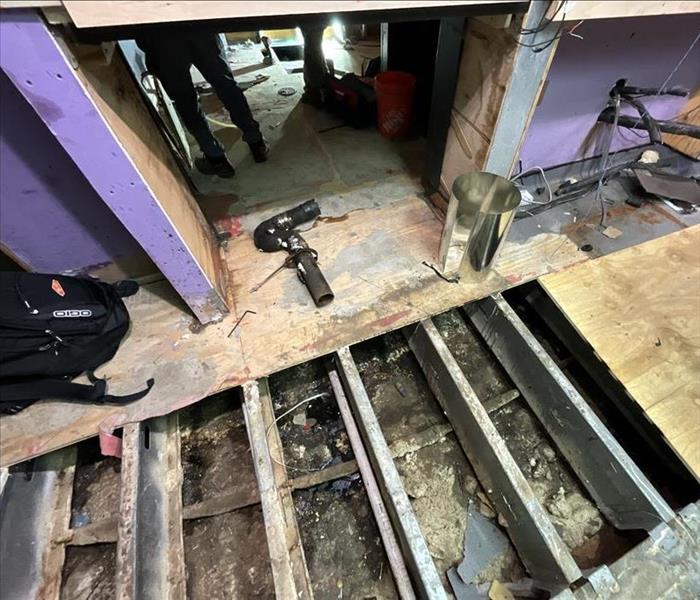How Mold Affects Different Types of Flooring: Expert Insights for Prevention and Restoration
11/13/2024 (Permalink)
 This article gives expert insights on mold's impact on flooring materials, backed by statistics and professional tips.
This article gives expert insights on mold's impact on flooring materials, backed by statistics and professional tips.
When it comes to protecting your home or business in Boston, MA, mold can be an enemy lurking in the most unsuspected places—especially in your flooring. Mold thrives in environments where moisture is present, and if left unchecked, it can cause extensive damage to various types of flooring. However, not all flooring materials react to mold in the same way. Understanding how mold affects different types of flooring can help you take preventative measures or choose the best restoration strategy. This article gives expert insights on mold's impact on flooring materials, backed by statistics and professional tips.
Understanding Mold and Flooring: Why It Matters
Mold growth can occur at least 24 to 48 hours after water exposure. According to the Environmental Protection Agency (EPA), approximately 50% of U.S. homes have been affected by dampness and mold at some point. With this widespread risk, knowing how mold interacts with specific flooring types is crucial for homeowners and businesses. While mold might be most associated with walls or ceilings, flooring is particularly vulnerable due to its direct contact with moisture from spills, leaks, or floods.
How Mold Affects Different Flooring Types
1. Carpet Flooring
Carpet is one of the most susceptible materials to mold growth, as its fibers can absorb moisture and provide an ideal environment for mold spores to thrive. Even with proper cleaning, mold can grow beneath the carpet padding, making it difficult to detect until it becomes a larger problem.
Preventive Tips:
- Keep carpets dry by cleaning spills immediately.
- Regularly use a dehumidifier in high-humidity rooms like basements and bathrooms.
- If your carpet has been exposed to water for more than 48 hours, consider professional mold remediation to avoid further damage.
2. Hardwood Flooring
Hardwood flooring can develop mold on the surface or underneath if moisture seeps through the cracks between the boards. When mold invades hardwood, it can cause warping, staining, and discoloration. Unfortunately, once hardwood is affected by mold, it may be difficult to salvage without professional intervention, as the mold can penetrate deep into the wood fibers.
Preventive Tips:
- Ensure proper sealing between floorboards to prevent moisture intrusion.
- Regularly check for water damage near windows, doors, and plumbing areas that could affect hardwood floors.
- Use area rugs in high-moisture areas to limit exposure to water.
3. Vinyl Flooring
Vinyl flooring is often considered more resistant to mold growth due to its synthetic materials. However, mold can still grow beneath vinyl planks or tiles, particularly if there is water trapped between the flooring and the subfloor. If mold develops beneath vinyl flooring, it can cause peeling or lifting of the tiles, compromising the flooring’s integrity.
Preventive Tips:
- Always install a moisture barrier before laying down vinyl flooring in moisture-prone areas.
- Immediately address any water leaks to prevent water from seeping under the flooring.
- Regularly inspect the edges of your vinyl flooring for signs of moisture or lifting.
4. Laminate Flooring
Laminate flooring shares similarities with hardwood in terms of vulnerability to mold. Laminate boards are particularly at risk if water spills or leaks are not cleaned promptly. The materials in laminate floors can absorb moisture quickly, leading to swelling, warping, and eventually mold formation.
Preventive Tips:
- Use waterproof laminate flooring options in kitchens and bathrooms.
- Clean up water spills immediately, as standing water can penetrate the seams between planks.
- Install laminate over a moisture-resistant underlayment to reduce the risk of mold developing underneath.
The Importance of Professional Mold Remediation
Once mold has established itself in your flooring, DIY cleaning may not be enough to fully eradicate it. Professional mold remediation services, like those offered by SERVPRO®, can ensure that the mold is thoroughly removed, preventing recurrence and further damage to your flooring. With advanced equipment and expertise, SERVPRO professionals can assess the extent of the mold problem, contain the area, and restore your flooring as needed.
Key Takeaways for Preventing Mold in Flooring
- Act Quickly: Mold can develop in as little as 24 hours, so address moisture issues immediately.
- Regular Inspections: Frequently check areas prone to moisture, like kitchens, bathrooms, and basements.
- Use Proper Flooring for Each Environment: Choose mold-resistant flooring materials for high-moisture areas, such as vinyl or sealed hardwood.
Conclusion
Mold can affect nearly every type of flooring, but understanding how it interacts with different materials is the key to prevention and damage control. Whether you have carpet, hardwood, vinyl, or laminate flooring, taking proactive measures to limit moisture exposure and promptly addressing water issues can save your floors from the devastating effects of mold. Should you encounter a mold issue, partnering with a trusted remediation expert like SERVPRO ensures that your flooring and home will be protected for the long term. For more information on how to handle mold-related damage to your floors, visit EPA Mold Information.






 24/7 Emergency Service
24/7 Emergency Service